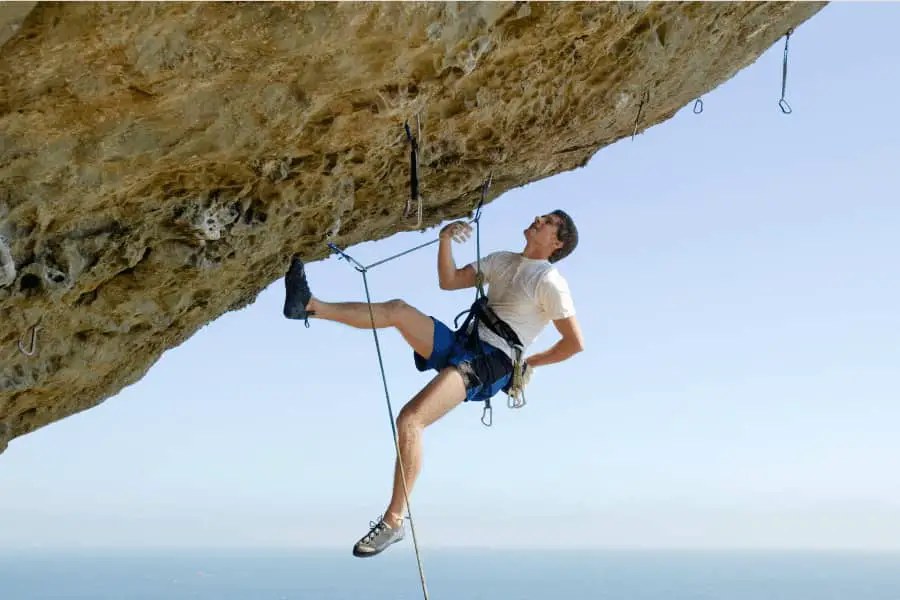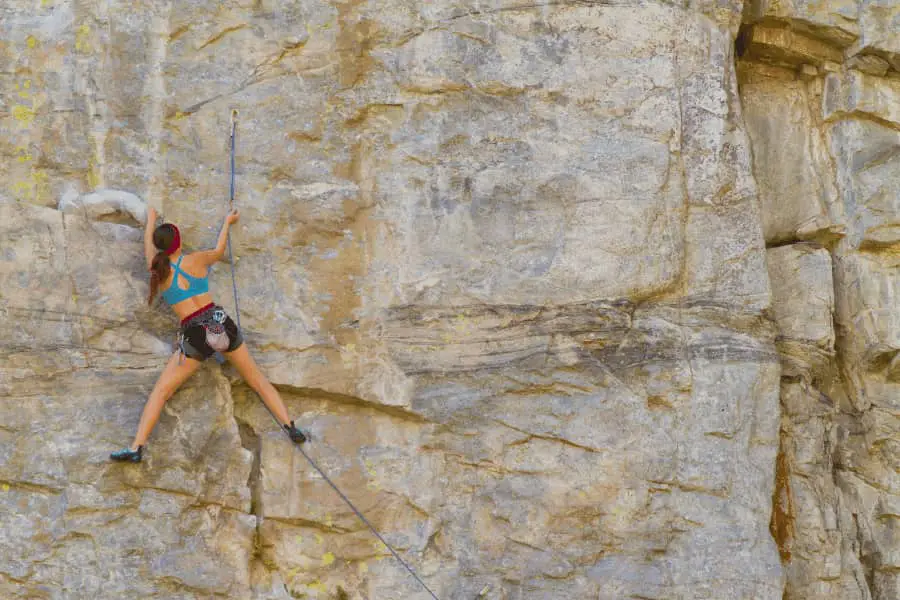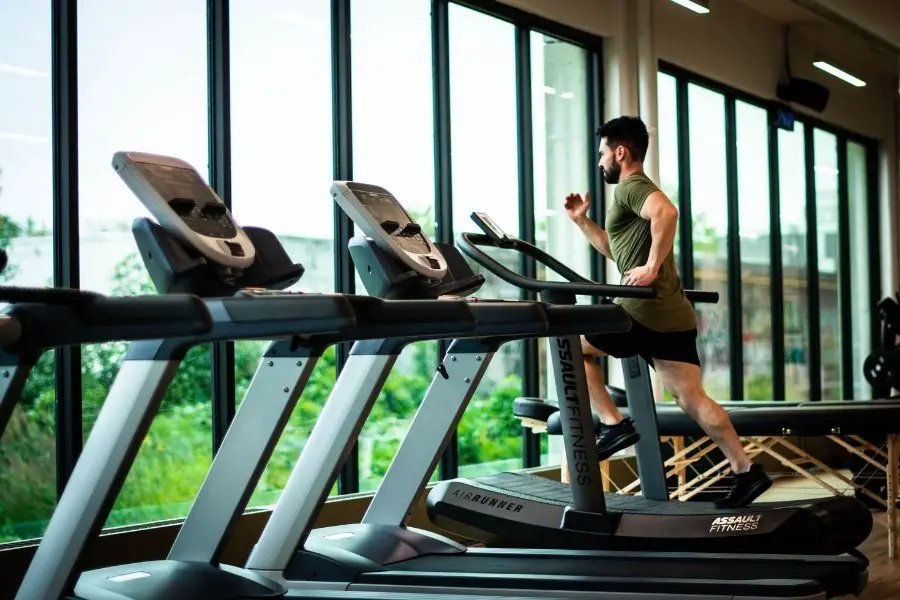
Transitioning from being able to climb 5.11 to 5.12 is a huge milestone in your climbing journey. I have learned that it takes hard work, consistency, and dedication to achieve this goal. 5.12b was the hardest grade I was able to climb at my peak performance and let me tell you, it took work to get there. Although I am not the most gifted climber, I am confident in saying that you will have to train to get there. (Unless you are just incredibly talented).
The best way to go from climbing a 5.11 to 5.12 is to develop a consistent training plan that will improve your climbing technique, climbing strength, and climbing endurance. Plan to climb at least 3 times per week and cross-train by weight lifting to maximize your results.
Focusing on certain aspects in each of these categories (technique, strength, and endurance) will help you level up your climbing very quickly. I lay out which of these aspects you should focus most on at your current level to get up to 5.12. I also provide the methodology in which I took to get there.
If you are interested in seeing what the current prices are for the most popular rock climbing training aids, you can find them on Amazon by clicking here. Using the Amazon affiliate link above and/or other links in the article helps support this website.
1. Improve Your Climbing Technique
I would argue improving your technique is the most important factor to go from climbing 5.11 to 5.12. Up until this point you have had to focus on having decent technique but ultimately could climb routes without great form. for 5.12 and up, this is no longer the case. Your technique will have to be on point.
It doesn’t matter how strong you are if you consistently set yourself up in bad positions. A weaker climber with great body positioning and technique will outperform stronger climbers with poor technique. Such is the way of the world in climbing.
Get Better Body Positioning On The Climbing Wall
Good body position is the most important thing to keep in mind when climbing. Bad body positioning will cause your center of gravity to be high and away from the wall. This puts more stress on your forearms and fingers to hold you onto the wall. The increased stress makes you try a lot harder and will cause your forearms to pump earlier on easier routes.
To get better body positioning, bend your knees on the wall and keep your hips directly above the foot holds. Bending you knees allows you to keep your hips low. This will drop your center of gravity on the wall. Dropping your center of gravity this way will allow you to keep your arms straight.
Keeping your hips directly above the foot holds will allow you to put most of your weight on your feet. Putting most of your weight on your feet is very important when climbing. This will reduce how hard you need to grip the holds. Reducing this need will allow you to use harder holds and will keep your forearms from pumping up as easily.
Focus On Your Footwork On The Wall
Having good footwork will automatically help you have good body position. When I was transitioning to climbing 5.12, I made sure that I was really practicing and taking full advantage of the following techniques:
- Smearing. This will help you balance and develop core tension when you are unable to reach the next foot hold.
- Toe hooks. These help you from swinging out off of holds and allow you to reach out further than normal.
- Heel hooks. These will help you create tension and pull yourself into the wall with your leg.
- Heel plant. This will help you put all of your weight on one foot and keep you hips into the wall.
- Inside edging. This will help you get both of your hips close to the wall and stand on your feet.
- Outside edging. This also allows you to get one of your hips directly onto the wall and is good for performing side pulls.
- Flagging. This will help you balance and develop core tension when your center of gravity is not directly above your foothold.
I would devote one session a week to just focusing on technique. Practicing these techniques over and over again help engrain them into you memory and you will naturally start to perform them without thinking about it.
Although upgrading you climbing shoes will not make you a better technical climber right away, they can help you better practice your footwork. As you go from 5.11 to 5.12, it may be time for you to start considering getting a better pair of shoes to help you get there. Keep in mind, new shoes won’t magically make you a 5.12 climber. To check out my recommended climbing shoes, check out my page linked here!
How To Work On Your Climbing Technique

The best way to improve climbing technique that I have found was simply to climb more. The more you climb, the more your body will get accustomed to the climbing movements. By focusing on the right way to climb and by practicing different betas, you allow your body to get a larger exposure to the moves you will face in 5.12.
Try not to focus on the grade of the routes so much when increasing your mileage. Try to instead focus on different routes that require diverse movement patterns. By practicing these different moves you will engrain the body positing and foot work required to do them correctly. This will help you climb harder routes that require that base technique later on.
2. Improve Your Climbing Strength
Climbing strength is much different than absolute strength. If you took the strongest man in the world and asked them to climb a 5.12, they wouldn’t stand a chance. Climbing relies heavily on relative strength. How strong your fingers, grip, and pulling muscles are relative to you body weight. The heavier you are, the stronger you will need to be to make up for it.
Going off of this, losing weight will help your overall climbing strength. You will have to move less weight up the wall and will feel stronger. That being said, losing weight is not necessary to get stronger and improve your climbing. In fact, if you lose too much weight your body will actually lose strength and you won’t have the energy you need to move yourself efficiently up the wall. The key is finding the right balance for yourself.
Identify Your Current Weaknesses When Climbing
The best way to get stronger quicker is to identify your weaknesses. What separates the good from the great is their ability to self-analyze. Self-analyzing will help you objectively determine what you are good at and not so good at. Knowing this, you can focus on that weakness while maintaining your strengths.
I climbed a bunch of different routes in the 5.10a to 5.10b range to help identify my weaknesses. Climbing these different routes will help you determine what moves you really struggle with. Ideally you will be able to climb all of these without too much difficulty and really hone in on what moves made you try the hardest.
If your gym does not have many of these 5.10a to 5.10b routes, go to the bouldering wall and climb all the routes 2 grades below your current best. This will function in the same way – to identify weak spots.
If you know you suck at crimps (like I did), start climbing crimp heavy routes. If you can’t move that well dynamically, start throwing dynos at problems and using deadpoints. You may have to start climbing “easier” routes (grade wise) when doing this. That is expected. Eventually you will start to get better at these and become a better, more well-rounded climber.
Turning your weakness into a strength is something that you can pride yourself on. This will take hard work and a lot of mental dedication. It can be fun to work on what you are good at, but purposely doing something your bad at takes a lot of will power. You will get frustrated. You may even feel embarrassed at times. But keep grinding and improving on your weak spots. It will pay off in the end.
The only way to get better is to practice doing it. You have to walk before you can run. No matter how frustrating that is.
Train Your Climbing Strength On The Climbing Wall
The best way to train your climbing strength on the wall is to practice hard moves over and over again. The easiest way I have found to go about this is actually by bouldering. Picking bouldering problems that require a large amount of strength output will help improve your climbing strength in sport climbing as well.

For my second session of the week when I was transitioning from 5.11 to 5.12, I would pick two different problems that required difficult moves that I was able to climb with a good effort. I recommend picking two problems that require very different moves. For example you could pick one problem that requires a lot of core strength and tension and a different problem that requires more grip and pulling strength.
I would climb one of these routes and then take a shot rest. After a few minutes, I would try it again. I would keep repeating this until I was no longer able to send the route after a few minute break. I would move on to the next route and repeat this same process.
The next training session I would try to get 1 more send on each problem than I did the last time. I was not always successful with this but was able to increase my strength over time. Once the routes started to feel easier and I was more comfortable with them, I would pick two new problems to do this with.
How To Weight Lift To Increase Your Climbing Strength
To help speed up the process of getting stronger, you can start to cross train by lifting weights. When doing this, you will want to focus on improving your grip strength, pulling strength, leg strength and balance. The best way to increase your strength in these areas is to train your forearms (grip strength), back (pulling strength), legs, and core (balance).
I wrote an entire article on the best weight lifting plan for rock climbing. It goes into great detail on the best way to train and what exercises are the most beneficial in doing so. It even talks about how you can alter the workout routine to your own personal abilities and goals. You can check it out here.
In short, you will want to focus on the following exercises:
- Pull-ups
- Squats
- Wrist curls
- Hammer curls
- Planks
Performing these exercises in conjunction with climbing will help you improve your climbing strength tremendously. However, these are not the only exercises you will need to perform.
Perform Antagonist Exercises In Conjunction With Pulling Exercises
Keep in mind that you will need to perform some antagonistic exercises on top of the ones listed above. Antagonistic exercises for climbers are exercises that involve pushing movements. Because you are constantly pulling yourself up the wall, your pulling muscles will start to overdevelop in comparison to your pushing muscles.
Working these pushing muscles will keep your body balanced out and can help prevent injuries. The best pushing exercises for climbers to perform are push-ups, bench press, dips, and military press. All of these exercises engage multiple pushing muscles at once (chest, shoulders, and triceps) making them the most time efficient exercises to perform.
Performing these antagonistic exercises are more of a necessity for advanced climbers than the average climber. If you wish to make climbing a big part of your life moving forward, I highly recommend to start doing these from the start to limit any imbalances that may arise.
3. Improve Your Climbing Endurance

Climbing endurance refers to how long you are able to stay climbing. This depends on how good your cardio is and how quickly your forearms get pumped. It is essential to get better in both of these areas when transitioning from 5.11 to 5.12.
Train Your Climbing Endurance On The Climbing Wall
For most climbers, your forearms are going to be pumped and give out before you get tired and run out of breath. You can train this by climbing more. For my third session of the week, I would pick routes a few grades below my then current level (anywhere between 5.9 to 5.10b) and climb them repeatedly.
By climbing a route back to back without a break you don’t allow your forearms to recover. This causes your forearms to tire and get pumped pretty quickly. Shaking this pump out and climbing again right after this helps you increase your climbing endurance.
I personally have found that climbing crimp heavy routes repeatedly worked the best at increasing my grip strength endurance. To do this, I would go to the climbing gym and top rope a crimpy 5.10a route over and over again until my grip strength would give out. I would then rest for a few minutes and repeat the process.
It is not important that you are top roping during this, it is just to train your grip endurance. you are not going for records or anything here. I recommend doing this 3 to 5 times during your climbing sessions. This will really beat up your forearms and will work on your cardio as well.
How To Cross Train Your Endurance
Climbing is a cardiovascular exercise and can be cross trained by doing other cardio exercises as well. Popular exercises include running, cycling, and swimming. A general rule of thumb is if you are exercising and become out of breathe and your heart starts beating fast, you are doing cardio.
What is the best method of doing cardio for climbing? The one that you enjoy and can stick to on a regular basis. If you hate running but like to cycle, then cycle your butt off! It doesn’t matter which is technically the best for you if you hate doing that exercise. Consistency is king when it comes to cardio.
Instead of interval training, focus on doing light to moderate intensity cardio. Interval training is great for bouldering because it helps your body put out short bursts of power. Sport climbing requires longer sustained efforts. Therefore, you should train your cardio in the same way – a longer sustained effort.
The bottom line? To go from climbing a 5.11 to 5.12 you will want to focus on improving your climbing technique, strength, and endurance. The best way to do this is to identify your weak points and increase your mileage. Cross training by lifting weights can help you achieve your goals quicker.
